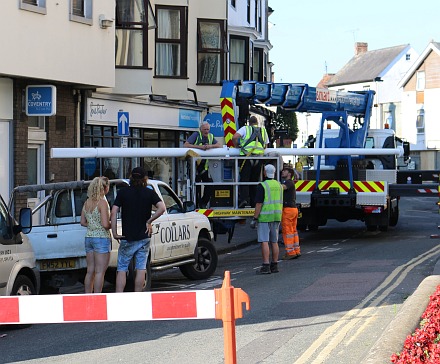
There was a road closure early this morning to allow Ecclesiastic Steeplejack Ltd to install the new flagpole on the County Hall in Abingdon
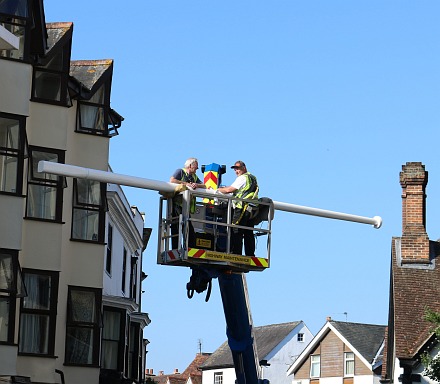
The old pole had been shortened – to cut out the rot, resulting in flags being buffeted against the guy wires. The new timber pole is back to the original length of 6.7 meters.
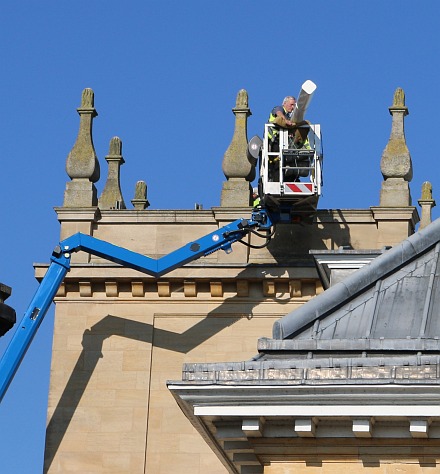
It is finished in white marine gloss paint which will last for many years to come.
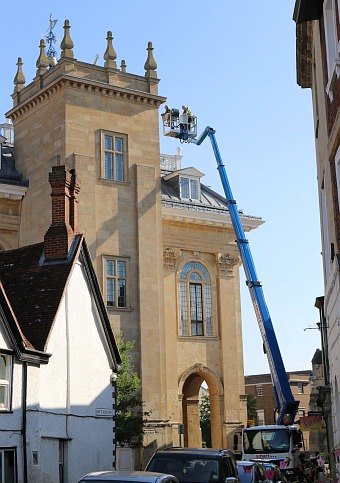
In this picture the new pole can be seen balanced across the walls at the top of the staircase as the giant cherry-picker brings the steeplejacks safely back to earth.
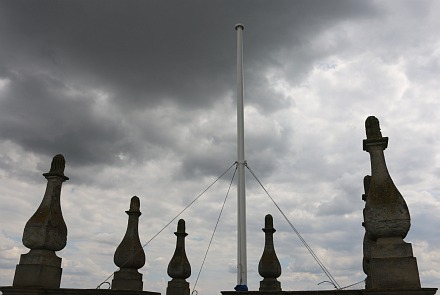
The new flagpole is now held in position by four guy wires – all ready for whatever flags the Town Council’s policy allows to be flown, and whatever winds buffet the flags.
£15k. Half the annual amount needed to keep South Abingdon Childrens Centre going….
Yup disgraceful, a smaller flag would have worked just as well
So please can we name and shame those responsible for this expenditure ?
Start with the leader of the council, Mike Badcock. He reads this blog so can justify his decision if he chooses
Goodness me. Goodness gracious me …
Let’s imagine the pole lasts for 15 years. It then costs £1000 per year (or £19.50 per week). Much less than the average household’s food bill for the week. Much less than the average cost of a family holiday. Much less than cost of petrol/diesel for an average family car. And that £1000 is spread out across 33,100 people – which means 3p per person per year.
The County Hall is one of the glories of Abingdon and the flag mast needs to be fairly big – otherwise, it will end up looking like a cocktail stick.
On the other hand one could argue that our old town hall had a flag pole on it long before we had a children’s centre and is probably seen ( and it’s flags enjoyed ) by thiousands more ?
£15k for a flag pole? I know it probably couldn’t be a standard one but after a quick Google the most I can find one costing is £500.
Well, at least Abingdon has erected an enormous flag pole in the middle of town. Freud would be very proud.
PPJS – similar arguments can be applied to every area of TC spending: taking each one individually – even big projects like the Guildhall – the sums work out as peanuts per household. What appears to be lacking is any sense of vision/prioritisation: rather than building the budget bottom-up, based on what we have always had/done, how about looking at what is really important for the wellbeing of the town and its inhabitants? Identify these issues – plus of course core expenditure on essential services – and base the budget around these, with provision of a small amount for discretionary expenditure.
Hester:
I agree that budgets have to indicate and cost priorities – something I have argued on this blog on several occasions. Your comment about identifying the main areas of expenditure for continuing services and having a small amount for discretionary expenditure makes my point.
In the light of the overall budget, a flagpole once every 15 years (it will probably last more than that unless we experience freak windstorms) is a very small worry I would have thought.
I agree with Heston, no long term vision for Abingdon, a well thought out Guildhall project would serve the local community for 30 + years. Instead of that we get a new flag pole, that most people in Abingdon, the people who untimely paid for it, probably will never know was done, or benefit from.
I derive a great sense of pleasure and belonging each time I drive or walk past County Hall (I suspect it was originally called something like market hall) and the Union Flag is a fine finishing touch to this magnificent building, which Pevsner said was the best in the country. It is a great pity that OAP’s, like myself, cannot go inside it.
So can we get the clocks on St Nicolas’ church repaired next?
They are the only clock faces visible from the Market Place and have been telling the correct time exactly twice a day for many months now.
the worry is…is there is no faith that the council got the best deal possible for their flagpole. I would rather pay 2p per year, than 3.
However, it is perfectly predictable that in this case the TC chose to take the p.
Hester, I know you’ll correct me if I’m wrong but wasn’t the children’s centre funded by OCC and not the town council?
Wasn’t it OCC who pulled funding?
I wonder if replacing the flagpole with a much larger one so soon after receiving such awful (and national) publicity over the refusal to fly a Rainbow flag is the Town Council way of flipping the bird at the world?
If we have a new flagpole the next thing they will get will be a new flag to go up it! Why can they only fly the flag on high days and holidays? Let us be proud of our town and fly it every day! Otherwise somebody will cost out the cost per showing!
Geoffrey, couldn’t agree with you more, especially when you think how many of our forefathers fought & died hoisting the union flag somewhere in the world? Was it Sandy Woodward who sent the message back to London from the Falklands “may it please your majesty once more the Union Flag flies over Port Stanly”?
For me the cost of seeing the flag high over Abingdon? Priceless!
Capt K (post 16). You are of course right that it was OCC who pulled the Childrens Centre Funding. However, they made a small pot of money available to help groups who could put together business plans and alternative funding sources to run replacement services. In various areas groups have managed to do that and in some of them the package put together involved a contribution from the local Parish Council.
Earlier this year Abingdon TC agreed that if the South Abingdon CC group were successful in putting together a package to meet the OCC criteria and could show acceptable business plans, they would contribute £30k p.a towards that package for 3 years.
My understanding of the current situation is that OCC have now accepted the South Abingdon business plan, but the Town Council want to make their own assessment before releasing their contribution; because it needs to go through various committee stages and we are now entering the summer holiday period there is some doubt as to whether the group will be able to commit to the contracts they need to put in place in order to be up and running in September.
I don’t think anyone is arguing over we should “fly the flag”, and a big one at that – whether a colourful rainbow one, or a Union one…I think the concern, the perception, is that there is no confidence that the relevant party would look to spend a sensible amount to do so.
There is often money spent willy nilly on things…or so it seems; was this the very best flagpole, obtained for the very best price…or was it just a flagpole, bought no matter the cost?
If I remember rightly, the four trees – then mere saplings – on the market place cost us £18,000….I think we just want reassurance that we got a good deal.
Abingdon is all to used to getting bum deals, as opposed to good ones. That’s all….
Very pleased to see this flagpole go up. Will be a fitting topping out of the restoration of the guildhall and general tidy up of the centre of town.
Since moving to the area 17 years ago, Abingdon town centre has improved markedly.
The only issue is steady failure of so many independent retailers, but that’s not unique to Abingdon.
We could stop spending money on this and that to fund something or other. In the end it’s choices, and as others have pointed out, I’m happy to pay 3p a year to brighten up the town centre a little bit more.
Very easy to criticise.
Costing the flag is relatively simple: The flagpole cost £15K and will last 15 years. £1000 a year.
Flags are flown for the equivalent of about one month a year: 30 days. Let’s say flags need to be taken up and taken down about 10 times in that period, as sometimes they stay up for a few days. Each time takes about half an hour of a council worker’s time to put up or down. Let’s say that council worker is paid about £10 an hour (to make my maths easy).
Union Flags cost around £300 (thank you, google), and last up to five years. That is £60 a year. I have no idea about other flags that might be purchased.
So every day a flag is flown costs the council around £40.
Simples
OK. I admit it. I am not a project manager or quantity surveyor, so there is no need to forensically analyse my figures. They are probably off by a mile. But the cost of flag flying is not peanuts.
Hester, if you want something bad enough you have to make things happen, it’s no good expecting the public pot to fund everything, there are hundreds of other funding opportunities open to that cause, but you have to go and chase them, meanwhile here’s a start for you? (Sorry backstreeter)
1. Sir Tom Hunter
Wealth: £1.06bn.Donations: More than £1.01bn.Causes: The Hunter Foundation, Scottish educational programmesand overseas youth projects.Pledging to donate more than £1bn to good causes is an unusually mammoth vow, even for the richest man in Scotland. But Sir Tom Hunter is no ordinary philanthropist and the tremors his enormous commitment made last year are still being felt. Sir Tom made his fortune from his sports retail chain Sports Division, which he sold to JJB Sports in the 1990s. The venture capitalist then turned venture philanthropist. Over the next few years, he and his wife plan to give away the majority of the profits from their private equity vehicle West Coast Capital, which invests in such high street retailing giants as BHS and Office. The couple have already donated in excess of £100m to their charity, the Hunter Foundation, over the past 10 years.
2. Christopher Hohn
Wealth: £110m.nations: £236.8m.Causes: £2.9m to the Clinton Foundation for the treatment of HIV/Aids orphans in Malawi, emergency aid to places such as Darfur.Mr Hohn and his wife, Jamie Cooper-Hohn, set up the Children’s Investment Fund Foundation five years ago and have donated more than £800m to the fund. Mrs Cooper-Hohn heavily researches suitable causes for the charity, and much of the money is channelled through projects in Africa.
3. Lord Sainsbury Wealth: £1.3bn.Donations: £233.8m.Causes: The Gatsby Charitable Foundation, a grant-giving organisation which supports education, medicine, science and the arts.He may be from the family which brought us a supermarket, but David Sainsbury’s activities do not stop there. He handed out one of the largest donations ever made to a British university this year. The £82m sum will fund 120 scientists to work at a research facility at Cambridge.
4. Peter Cruddas Wealth: £1.2bn.Donations: £100m.Causes: Education and youth-based programmes.The billionaire son of an East End market trader set up the financial trading group CMC Markets 19 years ago then created the Peter Cruddas Foundation two years ago, and has given more than £100m of his personal fortune to youth-based charities. He once said: “I think it is quite obscene for one person to have such large amounts of money. I am beginning a process to redistribute it to society.”
5. David and Heather Stevens Wealth: £100m after tax.
Donations: Gave £100m of shares to charity last year.Causes: Environment, children and medical charities.Their ranking in the Sunday Times Rich List may have slipped from 608th to 784th in the past year, but the founding managers of the British insurance company Admiral are still worth at least £100m. The husband and wife partnership have donated the same sum to various charities over the past year.
6. George Weston Wealth: £1bn.Donations: £97m.Causes: Churches, youth groups and housing corporations benefit from grants given by the Garfield Weston Foundation.
George Weston, 44, and his family hold a £900m stake in Associated British Foods, which he took control of in 2002. It owns brands such as Twinings, Kingsmill, Jordans and Primark. Mr Weston donates vast sums through the Garfield Weston Foundation – a charity named after his grandfather and set up in 1958.
7. Anthony d’Offay Wealth: £130m.Donations: £97m.Causes: Education in the arts and national heritage.The contemporary art dealer – who has represented the likes of Joseph Beuys and Jeff Koons – sacrificed £98.5m of the value of an art collection to make it affordable to the National Galleries of Scotland and the Tate. He sold the 725 works, valued at £125m, for the comparatively meagre sum of £26.5m, so they would be available for public viewing. Other charitable acts by the dealer include fundraising to help pay for Rachel Whiteread’s work Monument in 2001.
Donations: £50m.Causes: The environment, autism charities and the Shimon Peres Foundation.Johan Eliasch, a former deputy treasurer of the Conservative Party and environmental adviser to Gordon Brown, has also tried his hand as a film producer, banker, professional skier and chairman of the sports retailer Head. Currently chairman of global warming charity Cool Earth, he has bought areas of the Amazon to protect them from illegal logging.
9. Sir Ian Wood Wealth: £890m.Donations: £50m.
Causes: The Wood Family Trust, Scottish youth projects, economic growth in poorer countries.The Scottish oil tycoon made a fortune through his energy giant the Wood Group. He set up the Wood Family Trust in 2007 after earning £135m from shares, and has channelled his donations into citizenship schemes. WFT is active in Tanzania and Uganda. This year, WFT has given £2.4m to youth projects.
10. Bob Edmiston Wealth: £520m.Donations: £42.8m.Causes: Education and a charity he founded, Christian Vision.Importing cars and property sales don’t usually link with charity, but they do in Bob Edmiston’s case. The owner of IM Group and IM Properties donates a percentage of both companies’ profits to funding new schools in the Midlands. Christian Vision – set up 20 years ago – aims to reach one billion people across Africa with Christian radio to offer support and information.
11. Gordon and Anita Roddick Wealth: £60m.Donations: £38.1m.Causes: The Roddick Foundation prioritises human rights, poverty and environmentalconservation.year,Mr Roddick invested in a more humane system of keeping pigeons off buildings without causing them any harm. He and his late wife, Dame Anita, made more than £100m when they sold ethical cosmetics company The Body Shop. Since then, he has proved keen to continue his wife’s good work.
12. Arpad Busson Wealth: £250m.Donations: £37m.Causes: Absolute Return for Kids (ARK), whose gala dinner raised £27m from its celebrity guests last year.Mr Busson, a French financier who is engaged to Uma Thurman, is a founding trustee of the charity ARK, which was set up in 2002 to help poor and abused children. However, he lost £230m at the hands of the alleged fraudster Bernard Madoff, and it remains to be seen what effect this will have on his charitable work.
13. Sir Elton John Wealth: £205m.Donations: £30.2m.
Causes: Elton John Aids Foundation, Oxfam, Breast Cancer Research and many others.Sir Elton often receives bad press for his ostentatious celebrity parties, hissy fits and extravagance. But few would deny that the singer-songwriter is a force for good whose public and private generosity supports a staggering number of causes. He donates up to 30 per cent of money from ticket sales at each of his live performances.
14. Ros Edwards Wealth: £700m.Donations: £30m.Causes: Cambridge University and bursaries for female students.Mrs Edwards, a Cambridge graduate, donated £30m after Oxford and Cambridge sought £1bn from ex-students to help them match the funding enjoyed by the Ivy League colleges in the US. New Hall College has now been re-named after Mrs Edwards and her husband, who made their fortune selling computer software. It is now called Murray Edwards Hall.
15. Sir John Templeton Wealth: £500m.Donations: £40m.Causes: The John Templeton Foundation, the Templeton World Charity Trust, the TempletonReligion Trust.Sir John Templeton died in July at the age of 95, bequeathing millions to fund to his favourite causes: religion and science.
16. Michael Moritz Wealth: £651m.Donations: £25m.Causes: Christ Church college at Oxford University.Mr Moritz, who studied modern history at Christ Church in the 1970s, is a partner in the US venture capital group Sequoia Capital. He gave £25m of his fortune to the university this year – the biggest bequest it has ever received. The sum will be invested by Oxford University Asset Management to generate returns to be used as income to provide student bursaries.
17. Sigrid and Lisbet Rausing Wealth: £5.4bn.Donations: More than £20m.
Causes: Arcadia, the Sigrid Rausing Trust, human rights, environmental and cultural projects.The Rausing fortune sprang from Hans Rausing’s Tetra-Pak design for milk and juice cartons. His daughters, Sigrid and Lisbet, lead the family philanthropically. The Sigrid Rausing Trust advocates human rights, while Arcadia works to preserve natural and cultural treasures. Each charity has given away more than £85m so far.
18. Michael Spencer Wealth: £800m.Donations: £11m.Causes: More than 100 charities, including Asthma UK, Breast Cancer Research, the Gateway Society, Kids Company, MediCinema and Starlight children’s foundation.Sixteen years ago, the brokerage ICAP set up a charity day which raises funds for good causes. The scheme, which has raised more than £53m, is the brainchild of Mr Spencer, the company’s chief executive.
19. Jimmy Heselden Wealth: £205m.Donations: £10m.Causes: Hesco Bastion Fund, hospitals, hospices, children’s charities and community projects.Mr Heselden, a former coal-miner, made his fortune inventing a metal cage used to support motorway embankments and flood defences. He decided to use his wealth for good causes and this year set up the Hesco Bastion Fund with Leeds Community Foundation. He plans to bequeath another £1.5m next month.
20. JK Rowling Wealth: £560m.Donations: £4.2m.
Causes: One Parent Families Scotland, Comic Relief, Multiple Sclerosis Society Scotland, Children’s High Level Group and many more.The Harry Potter author and avid philanthropist released a short story collection earlier this month which sold a record 2.6m copies on its first day. Tipped to be the biggest seller of 2008 as well as the fastest, her book Tales Of Beadle The Bard has raised millions for the author’s charity, the Children’s High Level Group, which helps vulnerable children across central and eastern Europe.
21. Dame Vivien Duffield Wealth: Unknown.Donations: £4.2m.Causes: Arts, Jewish causes and education.Dame Vivien inherited £45m from her father, property developer Charles Clore, in 1979 and became chairwoman of the Clore-Duffield Foundation, which has donated £112m to charity. This year it bequeathed £4.2m, including £1m to the National Museum of Cardiff. In the 1990s, she raised half the funds for the £214m rebuilding of the Royal Opera House.
22. John Studzinski Wealth: £13.5m salary in 2006.Donations: £2m to £4m.Causes: Genesis Foundation, Tate Modern.Known to his friends as “Studs”, the American is one of London’s most successfulinvestment bankers and was dubbed the most generous businessman by the Beacon Fellowship in 2005. He has predicted tough times for the world of philanthropy but the recession did not stop the devout Catholic from donating £5m to the Tate Modern gallery in London.
23. Ole Gunnar Solskjaer Wealth: Undisclosed.Donations: £2m.Causes: Unicef, youth education.Manchester United’s “baby-faced assassin” is almost as well known for charity work as he is for last-minute goals. Although injury forced him to retire last year, he did pull on the red shirt again in August for a testimonial match in his honour against Spanish club Espanyol. He has pledged to donate most of his £2m fee to the United Nations Children’s Fund, for which he is Norwegian ambassador.
24. Peter Harrison Wealth: Unknown.Donations: £1.5m.Causes: The Peter Harrison Foundation, sports, education and charities for the disabled.Most philanthropists like to see a visible return for their cash but Peter Harrison, a self-made businessman, was happy to give £1.5m this year to pay off the long-standing debt of the Jubilee Sailing Trust, a charity which allows the physically disabled to crew large sailing ships. The trust had been planning to sell one of its ships to repay the debt. Mr Harrison made his money selling his computer networking business, Chernikeeff.
25. Rory Brooks Wealth: Unknown.Donations: £1.4m over three years.Causes: The Rory and Elizabeth Brooks Foundation helps charities such as the Institute of Cancer Research.Rory Brooks, who heads the private equity investment group MML Capital, gave £1.4m to the Brooks World Poverty Institute at Manchester University. His contribution, as well as £2m from the university, is used to research poverty and inequality.
Thanks Capt K – I completely agree that philanthropists are a useful source of funding for major projects – the sort of thing that is sometimes described in these blogs as “vanity projects” – and I hope you have sent it to the Town Council so they could use it for the Guildhall.
However, call me old-fashioned – or a lefty, do-gooder or whatever – but I still think that the welfare and well-being of our children is so important that it should be underwritten by the state, not left to the energies of those willing to – and with the ability to – chase after funding.
My goodness. CaptainK’s post is nearly as long as an Abingdon flagpole.
(see! I invented a new simile)
My goodness. CaptainK’s post is nearly as long as an Abingdon flagpole.
(see! I invented a new simile)
Super flagpole, and we should all be very pleased with how Abingdon looks just now (especially the flowers).
Well done the TC.
Makes Abingdon a pleasure to visit and live in.
And, DavidofLuton, it did not cost £15,000 – the post, not your simile – mind you, was that simile or a comparison. There is a difference 😉
A fascinating list CK2 but surely it simply proves that the very wealthy have more money than they could ever sensibly need and a tiny proportion of them chose to use some of that money philanthropically (while others use lucrative directorships on charitable foundations to further their wealth while reducing their tax burden and looking good in the public eye)? Why not bring in a sensible taxation regime to make sure they all give, not just the generous, and use those funds for the benefit of all? I believe at last count there were 134 billionaires in the UK and only a tiny fraction of those are in your list. Imagine the good that could be done with some of their ‘spare’ money.
As I understand it, designing such a tax regime is relatively simple. Collecting it is fiendishly difficult. The super-rich move out or employ clever avoidance schemes.
Of course, pension fund managers (upon whom many of us rely) are equally adept at avoiding tax. Very few pensioners complain….
Apologies, a couple of previous posts of mine have appear under the heading stppjs – not so much a saint as ham-fisted!
I’m no expert…and I am quite certain that an awful lot of money could be easily spent asking one, but wouldn’t it be better to tax us all when we spend, rather than when we earn?
A purchase tax would effect us all equally….but i can choose to be ‘wealthy’ and not buy a Ferrari, or spend my money on one and be taxed accordingly?
Or is it so obvious an answer that the wealthy, tax negating leaders, simply wouldn’t ‘go for it’?
We have a purchase tax it is called VAT and the current rate is 20% on goods and services.
No, that is “Value Added Tax”, and is in addition to tax on earnings. That is not what i mean.
I mean a purchase tax. Plain and simple, and that is all. Sone things are taxed gently – apples, nappies, marijuana. Rolex watches, sausage rolls, Ferrari’s can be taxed higher.
To be honest, it’s not really my idea…but i think it’s quite a good one.